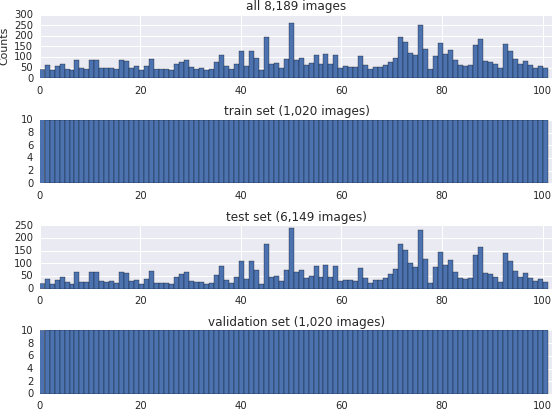This bootstraps Caffe training to classify images in the Oxford 102 category flower dataset. The prototxt files for fine-tuning AlexNet and VGG_S models are included and use initial weights from training on the ILSVRC 2012 (ImageNet) data.
To download the Oxford 102 dataset, prepare Caffe image files, and download pre-trained model weights for AlexNet and VGG_S, run
python bootstrap.pyThis will download files for the images, class labels, and train/val/test splits from the Oxford CV group's site. Some files are in MATLAB's .mat format so we use scipy to read those. A sample of the pretty flower images:
A plot of the class distributions for each split follows. It seems odd that there are more testing images than training images and that the training and validation sets are stratified but the test set isn't.
This model is a slightly modified version of the ILSVR 2012 winning AlexNet. The number of outputs in the final dense layer has been set to 102 to reflect the number of flower categories. Hyperparameter choices in AlexNet/solver.prototxt reflect those in Fine-tuning CaffeNet for Style Recognition on “Flickr Style” Data. The global learning rate is reduced while the learning rate for the final fully connected layer is increased relative to the other layers.
Once you've run the bootstrap.py script, you can begin training from this directory with:
cd AlexNet
$CAFFE_HOME/build/tools/caffe train -solver solver.prototxt -weights pretrained-weights.caffemodel -gpu 0After 50,000 iterations, the top-1 error is 7% on the test set of 1,020 images:
I0215 15:28:06.417726 6585 solver.cpp:246] Iteration 50000, loss = 0.000120038
I0215 15:28:06.417789 6585 solver.cpp:264] Iteration 50000, Testing net (#0)
I0215 15:28:30.834987 6585 solver.cpp:315] Test net output #0: accuracy = 0.9326
I0215 15:28:30.835072 6585 solver.cpp:251] Optimization Done.
I0215 15:28:30.835083 6585 caffe.cpp:121] Optimization Done.
The Caffe model can be downloaded at https://s3.amazonaws.com/jgoode/oxford102.caffemodel. You can also use the Caffe utility to download from its gist:
cd $CAFFE_HOME
./scripts/download_model_from_gist.sh 0179e52305ca768a601f <dirname>This is another popular CNN from the University of Oxford Visual Geometry Group (VGG). On ILSVRC 2012, it has a top-5 error rate of 13.1% compared to 15.3% for AlexNet.
Getting the prototxt file setup for training took a little more work because only the deploy.prototxt file was provided. I added the same learning rate multipliers for each layer as the AlexNet one and the same weight initialization schemes, although the latter was redundant when starting with pre-trained weights. The same random cropping and mirroring are also used.
To train,
cd VGG_S
$CAFFE_HOME/build/tools/caffe train -solver solver.prototxt -weights pretrained-weights.caffemodel -gpu 0After 14,500 iterations, this model does a little better with top-1 error of 5%. I stopped at 14,500 iterations because the loss had basically flat-lined:
I0917 13:26:48.291409 17111 solver.cpp:189] Iteration 14450, loss = 0.000572158
I0917 13:26:48.291549 17111 solver.cpp:464] Iteration 14450, lr = 0.001
I0917 13:27:52.307510 17111 solver.cpp:266] Iteration 14500, Testing net (#0)
I0917 13:28:50.950788 17111 solver.cpp:315] Test net output #0: accuracy = 0.951129
These weights can be downloaded at https://s3.amazonaws.com/jgoode/oxford102_VGG_S_iter_20000.caffemodel.
AlexNet uses a crop size of 227 x 227, while VGG_S uses 224 x 224, so it's not an exact comparison.
-
A more detailed blog post on this can be found at http://jimgoo.github.io/flower-power/.
-
The class labels for each species were deduced by Github user m-co and can be found in the file
class-labels.py. They are in order from class 1 to class 102 as used in the mat files. -
These were run using the mean image for ILSVRC 2012 instead of the mean for the actual Oxford dataset. This was more out of laziness that anything else.
-
This paper reports 87% top-1 accuracy on the Oxford-102 dataset using an SVM on features from the OverFeat model. I couldn't tell which split they used for training.

